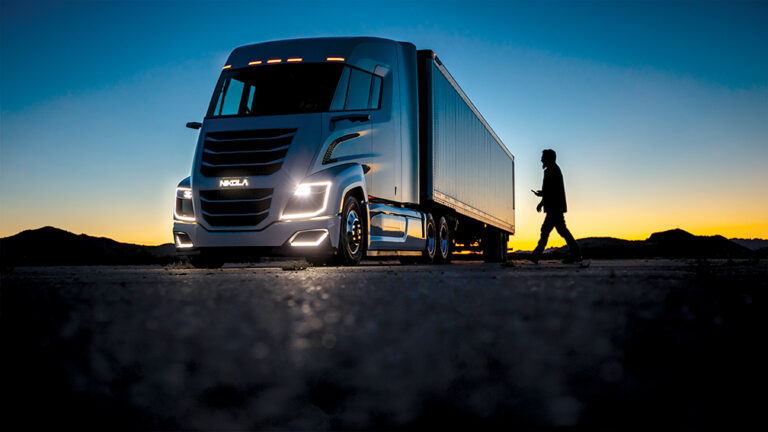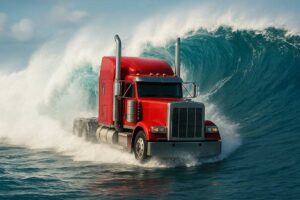Zero-emissions vehicles aren’t on the horizon for the trucking industry — they’re already here. Every major truck manufacturer now offers electric versions of their medium- and heavy-duty models, and new builders are carving out their own market niches.
And those in the industry are buying.
Currently, the use of zero-emissions vehicles is restricted by range and the availability of charging facilities and/or alternative fuels, but solutions for both of those issues are evolving. In the meantime, the U.S. Environmental Protection Agency (EPA) recently announced another round of diesel-emissions standards for heavy-duty trucks that require reduction of nitrogen-oxide emissions by up to 90% by 2031 over current standards.
Implementation of the technology required to further reduce emissions will undoubtedly drive new truck prices upward. Diesel fuel reached a new record high March 14 with a national average price of $5.25 per gallon, according to the U.S. Energy Information Administration. Even with a return to more reasonable fuel pricing, the total cost of ownership (TCO) for diesel-powered vehicles won’t be declining any time soon.
The TCO for battery-electric vehicles (BEVs) and fuel cell electric vehicles (FCEVs), on the other hand, has reached a point where more buyers are choosing zero-emissions vehicles on the basis of cost. That’s according to a study conducted by ACT Research titled “Power Up: Global Commercial Electric Vehicle Markets to 2040.”
The study, which included more than 85 unique commercial vehicle applications in more than 20 countries, showed 72% of the electric vehicles in use were less expensive — including purchasing and maintenance cost — than equivalent diesel-powered vehicles. In the U.S., that number rose to 75%. Those costs include both initial purchase and the expense of battery replacement.
To be sure, the most cost-effective uses for electric tractors are on regular routes that return to the same location, including charging stations, each day. Trash trucks, buses, local beverage deliveries, and peddle runs currently are best suited for employing the technology. Further advancements in the technology are needed before EVs can be considered for long-haul, irregular-route use.
Adoption rates for electric vehicles are expected to grow quickly, according to ACT Vice President of Electrification and Autonomy Ann Rundle.
“We were at a 1.0% to 1.5% adoption rate in 2020,” she explained. “As the new 2027 emissions regs take effect, we’ll see something like a 10% adoption rate, just by virtue of the improvements in technology. By 2030 we’re at 30% to 35%, and when we get to 2040, we’re past 50%.”
Some carriers are already committing to the purchase of commercial EVs. Anheuser-Busch, Covenant Logistics, Saia Freight, USA Truck, Heniff Transportation, and PGT trucking have all signed letters of intent to purchase BEVs and FCEVs from Nikola within the next two years.
Others have bought, or committed to buy, electric versions of more common brand names, such as Freightliner, Kenworth, Peterbilt, and Volvo. Most carriers are, at the very least, reviewing their operations to see where zero-emissions vehicles might fit, even if they aren’t ready to commit.
One market that is generally slower to invest in new technology is the owner-operator group, which tends to let the larger carriers work the bugs out before entering new markets. Four TCA Owner-Operators of the Year winners — Glen Horack (2021), Bryan Smith (2020), Kevin Kocmich (2019), and Dan Jewell (2018) — shared their thoughts on EV tech.
“I can see it’s going to come, eventually, but (the technology) has a long way to go before I personally would want anything to do with it,” noted Smith.
Smith said the charging process, at least at present, is more akin to finding a parking space with charging capability than to pulling up to a pump to fuel.
“You’d have to set up truck stops with plug-in cords throughout the parking lot,” he said.
Smith also pointed to energy-consuming accessories such as air conditioning, air dryers, and stereos.
“I can see a lot of trucks sitting on the side of the road because they just ran out of power, and I’m thinking, it’s gonna happen unless they really set up the infrastructure,” he opined.
Kocmich hauls specialized freight and often delivers to job sites and locations off the beaten path.
“Our situation changes from hour to hour,” he said. “We could be sitting at a job site all day or held up by inclement weather when it isn’t legal to drive. Unless we’re near a charging station, we could be stranded with dead batteries.”
Jewell acknowledges that EVs are likely the wave of the future but said the technology has a long way to go.
“It’s a coming thing, I do believe, but I don’t think it’ll get here until they get the infrastructure set up right,” he shared.
Jewell delivers feed supplements to grain elevators and other locations that often aren’t near interstate highways or metro areas.
“They could put charging stations there, but it’s a long time down the road,” he concluded.
Horack is more concerned about autonomous technology, which could easily mesh with zero-emissions vehicles.
“I don’t want to be a babysitter for a truck that drives itself,” he explained. “I can definitely see myself driving an electric truck, but I’m close to retirement and just don’t see it happening before I retire.”
Horack teams with his wife and averages 1,100 miles per day throughout the lower 48 states.
Hydrogen could provide an answer to the range issues of EVs, either by being burned directly as a fuel or combined with oxygen to produce electricity in FCEVs. The production of hydrogen, however, presents issues of its own.
One of those issues is efficiency. A common method of manufacturing hydrogen, steam methane reforming, requires large amounts of energy. When all the inputs are considered, only about 25% of the energy used to produce the hydrogen is actually converted to vehicle power. That’s comparable to the diesel fuel in use today.
The second issue is emissions. Unless hydrogen is produced using renewable energy sources, such as windmills, the manufacturing process isn’t actually any better for the environment than burning fossil fuels.
There is no scheduled point on the horizon on which zero-emissions vehicles will replace all diesels.
Like the teamsters of old who traded their horse-drawn wagons for “newfangled” horseless transportation, the trucking industry will transition as the zero emissions technology evolves, costs come down, and refueling/recharging options become easily attainable.
Cliff Abbott is an experienced commercial vehicle driver and owner-operator who still holds a CDL in his home state of Alabama. In nearly 40 years in trucking, he’s been an instructor and trainer and has managed safety and recruiting operations for several carriers. Having never lost his love of the road, Cliff has written a book and hundreds of songs and has been writing for The Trucker for more than a decade.















